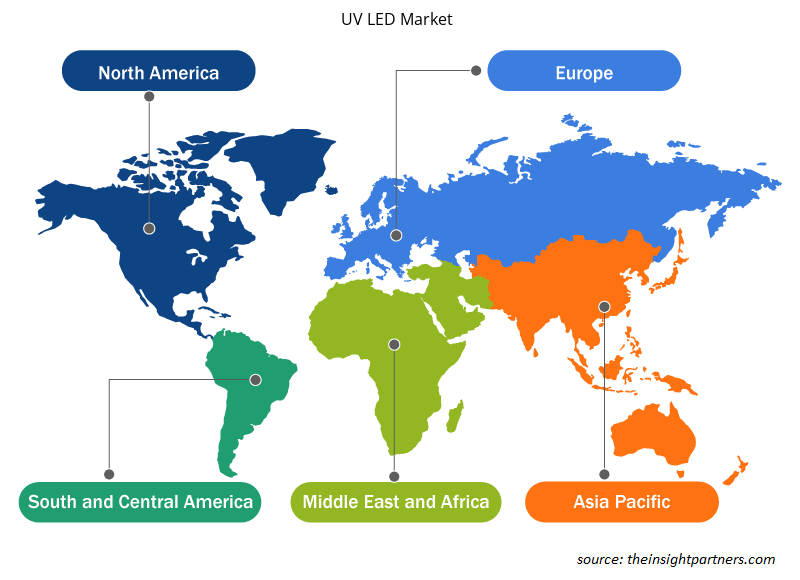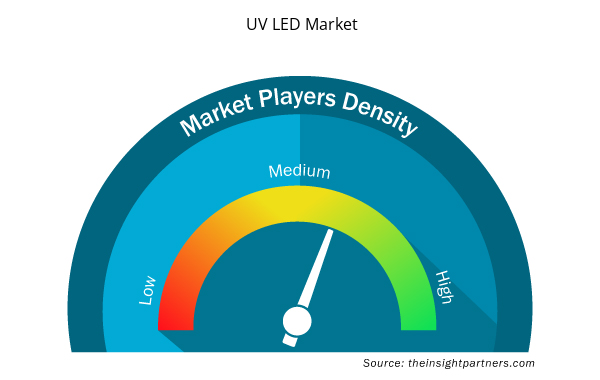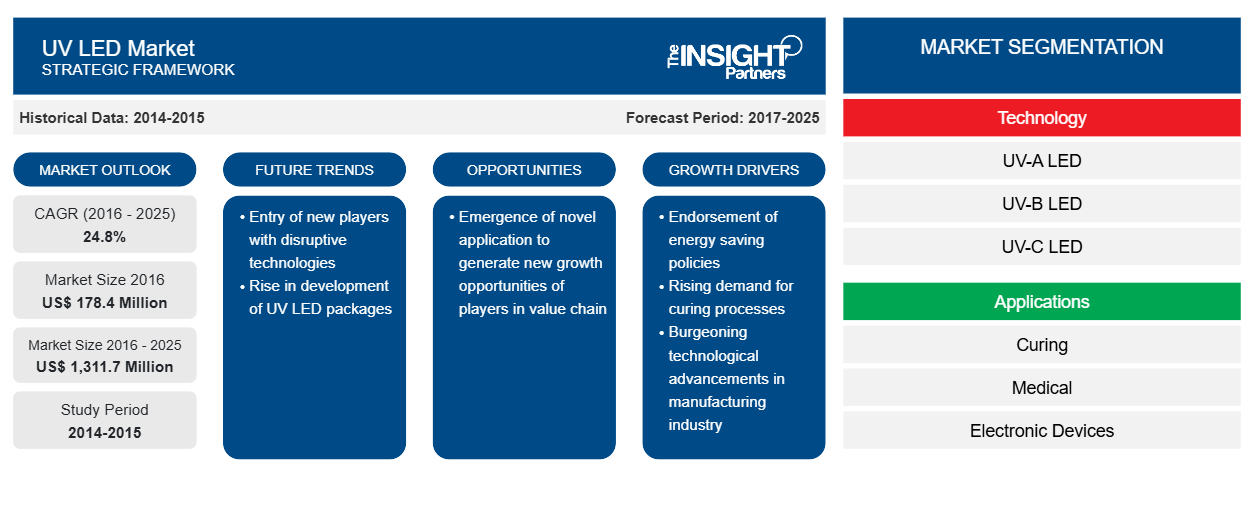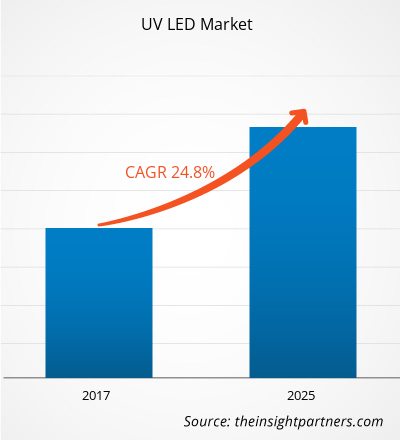[研究报告] 2016年紫外线LED市场价值为1.784亿美元,预计到2025年将达到13.117亿美元;预计2017年至2025年复合年增长率为24.8%。
分析师观点:
UV LED 市场报告指出,近年来,UV LED 市场经历了大幅增长,这得益于各行各业对 UV LED 的需求不断增长。UV LED 或紫外线发光二极管是一种固态照明技术,可发射不同波长的紫外线。与传统的紫外线灯相比,它们具有许多优势,包括节能、使用寿命更长、体积小巧和环保。UV LED 供应商在满足日益增长的 UV LED 需求方面至关重要。这些供应商为电子、印刷和制造等各个行业制造和提供高质量的 UV LED。他们提供各种 UV LED 产品,包括 UV-A、UV-B 和 UV-C LED,以满足不同的应用需求。
UV LED 的应用非常广泛。在医疗保健领域,UV LED 用于水和空气净化、消毒和灭菌过程。它们还广泛应用于工业制造过程,例如固化和干燥油墨、粘合剂和涂层。此外,UV LED 还可用于伪造检测、法医分析和园艺。UV LED 市场预计将在未来几年进一步增长,这得益于 UV LED 技术的进步、人们对节能照明解决方案的认识不断提高以及对有效消毒和净化方法的需求日益增长。UV 灯制造商将继续在满足市场需求方面发挥关键作用,确保提供高质量的 UV LED 来支持各种行业和应用。UV LED 照明因其众多应用和优势而备受关注。UV 灯 LED 发出紫外线,可用于各种行业,例如消毒、固化和荧光分析。一种特定类型是 250 nm UV LED,其工作波长非常适合灭菌和杀菌。此外,UV-C LED 因其能够产生具有杀菌特性的 UV-C 辐射而越来越受欢迎。UV LED 技术体积小、能效高、使用寿命长,使其成为许多需要紫外线的应用的首选。
市场概况:
紫外线 (UV) LED 技术可以从电能中产生紫外线。包括 UV-A、UV-B 和 UV-C 在内的多种技术都可用于制造 UV LED 产品。UV LED 的使用以前仅限于特定的细分应用,包括固化、伪造检测、取证等。UV LED 业务预计将受益于日益增长的趋势,即为新应用制造复杂的 UV LED 以及开发高效的 UV LED。近年来,UV LED 打印机市场经历了显着增长。与传统打印机相比,UV LED 打印机具有许多优势,例如更快的打印速度、更高的分辨率以及在各种材料上打印的能力。与此同时,UV LED 消毒盒批发市场也经历了显着增长。UV LED 消毒盒可高效方便地对各种物品进行消毒,包括手机、配件、婴儿奶瓶和个人防护设备。此外,UV LED 技术市场取得了重大进步并被广泛采用。该技术可用于各种应用,例如水和空气净化、假冒检测、医疗设备和工业流程。人们对可持续性的日益关注以及对高效环保解决方案的需求推动了 UV LED 技术市场的发展。
定制此报告以满足您的需求
您可以免费定制任何报告,包括本报告的部分内容、国家级分析、Excel 数据包,以及为初创企业和大学提供优惠和折扣
- 获取此报告的关键市场趋势。这个免费样品将包括数据分析,从市场趋势到估计和预测。
市场驱动因素:
紫外线固化系统利用率上升推动紫外线 LED 市场增长
UV 固化系统使用率的提高在推动市场增长方面发挥了关键作用,是主要的 UV 驱动因素。UV 固化是指使用紫外线瞬间固化或干燥涂料、油墨、粘合剂和其他材料。与传统固化方法相比,该技术具有多种优势,使其在各个行业中越来越受欢迎。市场增长的基本驱动力之一是 UV 固化系统提供的卓越性能和效率。与热或溶剂蒸发等传统方法相比,UV 固化提供更快、更精确的固化。此外, UV 固化系统具有显着的环境效益,进一步促进了其市场增长。与热固化不同,UV 固化不涉及有害挥发性有机化合物 (VOC) 的释放或有害副产品的排放。UV 固化是一种无溶剂工艺,减少了对环境的影响并最大限度地降低了工人的健康和安全风险。向更环保、更可持续的制造实践的转变促使许多行业采用 UV 固化系统作为可行的替代方案。UV 固化技术的多功能性是推动其市场增长的另一个因素。紫外线固化材料可用于各种基材,包括塑料、金属、玻璃和纺织品。
这使得紫外线固化系统可应用于各种行业,例如印刷和包装、汽车、电子和木材涂料。能够在各种表面上固化涂料和油墨的能力扩大了潜在市场,并推动了不同行业采用紫外线固化系统。对此类高性能涂料的需求不断增长,推动了对高效可靠的紫外线固化系统的需求。紫外线与 LED 固化系统市场呈现出动态格局。紫外线固化系统使用紫外线固化油墨、涂料和粘合剂,提供快速高效的干燥。另一方面,LED 固化系统采用 LED 技术实现相同目的。紫外线和 LED 固化系统各有优势,在不同行业和应用中更受青睐。这些系统的市场受成本效益、性能要求和与特定材料的兼容性等因素的影响。制造商和最终用户会考虑各种因素来确定哪种固化系统最适合他们的需求。
节段分析:
根据应用,UV LED 市场分为:
- 养护
- 医疗的
- 电子设备
- 水处理
- 安全
- 其他的
2016 年,固化领域占据了 UV LED 市场的最大份额,而水处理领域预计在预测期内将实现最高的复合年增长率。固化领域是 UV LED 市场的最大股东,因为它广泛应用于印刷、汽车、电子和包装行业。UV 固化系统具有速度更快、能源效率高和环境可持续性等优势。印刷行业在推动固化领域的增长方面发挥了重要作用。UV LED 技术的进步进一步扩大了 UV 固化系统的应用范围,巩固了其在市场上的主导地位。
区域分析:
2016 年北美 UV LED 市场价值为 0.036 亿美元,预计到 2025 年将达到 0.29 亿美元;预计在预测期内的复合年增长率为 26.1%。北美已成为 UV LED 市场的主导地区。该地区的主导地位可以归因于几个促成其市场领导地位的关键因素。首先,北美拥有强大的主要 UV LED 制造商和供应商。该地区拥有许多 UV LED 行业的知名参与者,包括 UV LED 芯片、模块和系统制造商。这些公司已投资于研发,使他们能够提供创新产品并推动市场增长。成熟的基础设施和 UV LED 技术专业知识使北美具有竞争优势,使其能够主导市场。其次,北美拥有广泛利用 UV LED 技术的多元化行业。这些行业包括汽车、医疗保健、电子、印刷和航空航天。这些行业对固化、灭菌和消毒等 UV LED 应用的需求很高。
该地区先进的制造能力以及有关能源效率和环境可持续性的严格规定进一步推动了 UV LED 技术的应用。第三,北美非常重视技术进步和创新。该地区以其在各个行业的强大研发活动而闻名。这种对创新的重视促进了新型和改进的 UV LED 产品和解决方案的开发。北美公司不断努力提高 UV LED 系统的性能、效率和可靠性,为该地区的市场主导地位做出了贡献。北美有利的市场条件,例如发达的基础设施、政府的支持性举措和强劲的经济,在该地区占据主导地位方面发挥了重要作用。这些因素为 UV LED 制造商和最终用户营造了有利的商业环境,推动了市场增长,并推动北美成为 UV LED 市场的前列。
欧洲 UV LED 市场正在经历大幅增长,这得益于该地区的几个特定因素。欧洲一直走在采用节能技术和可持续实践的前沿,这为 UV LED 应用的扩展创造了有利的环境。欧洲 UV LED 市场的一个重要驱动因素是人们越来越重视环境可持续性。与传统 UV 灯相比,UV LED 具有更高的能源效率和更长的使用寿命,这与欧洲致力于减少碳排放和推广绿色技术的重点相一致。这导致 UV LED 在整个地区的各个行业中得到广泛采用。此外,欧洲在汽车、电子和印刷行业占有重要地位,这些行业是 UV LED 技术的重要消费者。UV LED 用于这些行业的固化和干燥,提供更快、更高效的生产流程。该地区强大的制造业基础和对创新的关注促进了这些行业 UV LED 应用的增长。就 UV LED 供应商而言,欧洲拥有竞争激烈的格局,拥有多家老牌企业和新兴公司。这些供应商满足区域市场的不同需求,提供广泛的 UV LED 产品和解决方案。 UV LED 供应商、研究机构和行业参与者之间的合作促进了创新并推动了欧洲市场的增长。
亚太地区紫外线 LED 市场正经历快速增长,这得益于强劲的经济发展,尤其是在中国、日本和韩国等国家。该地区的电子、印刷和农业行业越来越多地采用紫外线 LED 技术,用于杀菌、固化和害虫防治等各种应用。市场受益于强大的制造商、供应商和分销商网络,提供广泛的紫外线 LED 产品。政府的支持和有利的能源效率法规进一步促进了市场扩张。韩国的紫外线固化树脂使用量相对较低,但在整个生产过程中仍然很重要。韩国的 LED 制造商即将推出一系列新的 UV-C LED 产品。技术密集型的 UV-C LED 预计将为亚太地区的市场扩张做出重大贡献。韩国 LED 制造商凭借其先进的技术、高质量的产品和强大的市场影响力,为该地区的紫外线 LED 行业做出了巨大贡献。
这些制造商利用其在 LED 技术和生产能力方面的专业知识,提供适合各种应用的各种 UV LED。他们专门开发和制造 UV-A、UV-B 和 UV-C LED,确保提供全面的产品组合,以满足行业的各种需求。韩国 LED 制造商以注重研发而闻名,不断努力创新和提高 UV LED 性能。这种对技术进步的承诺使他们能够提供效率更高、输出功率更高、可靠性更高的 UV LED。
UV LED 市场区域洞察
Insight Partners 的分析师已详尽解释了预测期内影响 UV LED 市场的区域趋势和因素。本节还讨论了北美、欧洲、亚太地区、中东和非洲以及南美和中美洲的 UV LED 市场细分和地理位置。

- 获取 UV LED 市场的区域特定数据
UV LED 市场报告范围
| 报告属性 | 细节 |
|---|---|
| 2016年市场规模 | 1.784亿美元 |
| 2025 年市场规模 | 13.117亿美元 |
| 全球复合年增长率(2016 - 2025) | 24.8% |
| 史料 | 2014-2015 |
| 预测期 | 2017-2025 |
| 涵盖的领域 | 按技术分类
|
| 覆盖地区和国家 | 北美
|
| 市场领导者和主要公司简介 |
|
市场参与者密度:了解其对商业动态的影响
由于消费者偏好的不断变化、技术进步以及对产品优势的认识不断提高等因素,终端用户需求不断增加,推动了 UV LED 市场快速增长。随着需求的增加,企业正在扩大其产品范围,进行创新以满足消费者需求,并利用新兴趋势,从而进一步推动市场增长。
市场参与者密度是指在特定市场或行业内运营的企业或公司的分布情况。它表明在给定市场空间中,相对于其规模或总市场价值,有多少竞争对手(市场参与者)存在。
在 UV LED 市场运营的主要公司有:
- 荷兰皇家飞利浦公司
- LG 电子公司
- 水晶股份有限公司
- 日亚化学工业公司
- 锋翔科技
免责声明:上面列出的公司没有按照任何特定顺序排列。

- 了解 UV LED 市场主要参与者概况
关键球员分析:
UV LED 市场分析包括荷兰皇家飞利浦、LG 电子、Crystal IS、日亚化学、Phoseon Technology、SemiLEDs Corporation、首尔伟傲世有限公司、英国豪迈、DOWA 电子材料有限公司和 Heraeus Holding GmbH 等参与者。在 UV LED 参与者中,Heraeus Holding GmbH 和 Phoseon Technology 凭借其提供的多样化产品组合位居前两位。
最新动态:
紫外线 LED 市场中的公司普遍采用并购等无机和有机战略。以下列出了一些近期的关键市场发展:
- 2022 年 3 月,Signify 与 Perfect Plants 就植物生长灯展开合作。两个新的气候单元配备了可调光的飞利浦 GreenPower LED 顶灯紧凑型植物生长灯和飞利浦 GrowWise 控制系统,提供了在每个生长阶段都可以有效、高效使用的照明系统。
- 2021 年 1 月,欧司朗推出了新款便携式 UV-C 空气净化器,用于对抗此次新冠疫情中的病毒。这种不可见的紫外线可杀死病毒,可靠性高达 99.9%。
- 历史分析(2 年)、基准年、预测(7 年)及复合年增长率
- PEST 和 SWOT 分析
- 市场规模价值/数量 - 全球、区域、国家
- 行业和竞争格局
- Excel 数据集


- Aerosol Paints Market
- Underwater Connector Market
- Foot Orthotic Insoles Market
- Small Internal Combustion Engine Market
- Compounding Pharmacies Market
- Piling Machines Market
- Artificial Intelligence in Defense Market
- Hydrolyzed Collagen Market
- Visualization and 3D Rendering Software Market
- Integrated Platform Management System Market

Report Coverage
Revenue forecast, Company Analysis, Industry landscape, Growth factors, and Trends

Segment Covered
This text is related
to segments covered.

Regional Scope
North America, Europe, Asia Pacific, Middle East & Africa, South & Central America

Country Scope
This text is related
to country scope.
Trends and growth analysis reports related to Electronics and Semiconductor : READ MORE..
The List of Companies
1. Koninklijke Philips N.V.
2. LG Electronics, Inc.
3. Crystal IS Inc.
4. Nichia Corporation
5. Phoseon Technology
6. SemiLEDs Corporation
7. Seoul Viosys Co. Ltd.
8. Sensor Electronic Technolgy Inc.
9. Halma PLC
10. Heraeus Holding GmBH
The Insight Partners performs research in 4 major stages: Data Collection & Secondary Research, Primary Research, Data Analysis and Data Triangulation & Final Review.
- Data Collection and Secondary Research:
As a market research and consulting firm operating from a decade, we have published and advised several client across the globe. First step for any study will start with an assessment of currently available data and insights from existing reports. Further, historical and current market information is collected from Investor Presentations, Annual Reports, SEC Filings, etc., and other information related to company’s performance and market positioning are gathered from Paid Databases (Factiva, Hoovers, and Reuters) and various other publications available in public domain.
Several associations trade associates, technical forums, institutes, societies and organization are accessed to gain technical as well as market related insights through their publications such as research papers, blogs and press releases related to the studies are referred to get cues about the market. Further, white papers, journals, magazines, and other news articles published in last 3 years are scrutinized and analyzed to understand the current market trends.
- Primary Research:
The primarily interview analysis comprise of data obtained from industry participants interview and answers to survey questions gathered by in-house primary team.
For primary research, interviews are conducted with industry experts/CEOs/Marketing Managers/VPs/Subject Matter Experts from both demand and supply side to get a 360-degree view of the market. The primary team conducts several interviews based on the complexity of the markets to understand the various market trends and dynamics which makes research more credible and precise.
A typical research interview fulfils the following functions:
- Provides first-hand information on the market size, market trends, growth trends, competitive landscape, and outlook
- Validates and strengthens in-house secondary research findings
- Develops the analysis team’s expertise and market understanding
Primary research involves email interactions and telephone interviews for each market, category, segment, and sub-segment across geographies. The participants who typically take part in such a process include, but are not limited to:
- Industry participants: VPs, business development managers, market intelligence managers and national sales managers
- Outside experts: Valuation experts, research analysts and key opinion leaders specializing in the electronics and semiconductor industry.
Below is the breakup of our primary respondents by company, designation, and region:

Once we receive the confirmation from primary research sources or primary respondents, we finalize the base year market estimation and forecast the data as per the macroeconomic and microeconomic factors assessed during data collection.
- Data Analysis:
Once data is validated through both secondary as well as primary respondents, we finalize the market estimations by hypothesis formulation and factor analysis at regional and country level.
- Macro-Economic Factor Analysis:
We analyse macroeconomic indicators such the gross domestic product (GDP), increase in the demand for goods and services across industries, technological advancement, regional economic growth, governmental policies, the influence of COVID-19, PEST analysis, and other aspects. This analysis aids in setting benchmarks for various nations/regions and approximating market splits. Additionally, the general trend of the aforementioned components aid in determining the market's development possibilities.
- Country Level Data:
Various factors that are especially aligned to the country are taken into account to determine the market size for a certain area and country, including the presence of vendors, such as headquarters and offices, the country's GDP, demand patterns, and industry growth. To comprehend the market dynamics for the nation, a number of growth variables, inhibitors, application areas, and current market trends are researched. The aforementioned elements aid in determining the country's overall market's growth potential.
- Company Profile:
The “Table of Contents” is formulated by listing and analyzing more than 25 - 30 companies operating in the market ecosystem across geographies. However, we profile only 10 companies as a standard practice in our syndicate reports. These 10 companies comprise leading, emerging, and regional players. Nonetheless, our analysis is not restricted to the 10 listed companies, we also analyze other companies present in the market to develop a holistic view and understand the prevailing trends. The “Company Profiles” section in the report covers key facts, business description, products & services, financial information, SWOT analysis, and key developments. The financial information presented is extracted from the annual reports and official documents of the publicly listed companies. Upon collecting the information for the sections of respective companies, we verify them via various primary sources and then compile the data in respective company profiles. The company level information helps us in deriving the base number as well as in forecasting the market size.
- Developing Base Number:
Aggregation of sales statistics (2020-2022) and macro-economic factor, and other secondary and primary research insights are utilized to arrive at base number and related market shares for 2022. The data gaps are identified in this step and relevant market data is analyzed, collected from paid primary interviews or databases. On finalizing the base year market size, forecasts are developed on the basis of macro-economic, industry and market growth factors and company level analysis.
- Data Triangulation and Final Review:
The market findings and base year market size calculations are validated from supply as well as demand side. Demand side validations are based on macro-economic factor analysis and benchmarks for respective regions and countries. In case of supply side validations, revenues of major companies are estimated (in case not available) based on industry benchmark, approximate number of employees, product portfolio, and primary interviews revenues are gathered. Further revenue from target product/service segment is assessed to avoid overshooting of market statistics. In case of heavy deviations between supply and demand side values, all thes steps are repeated to achieve synchronization.
We follow an iterative model, wherein we share our research findings with Subject Matter Experts (SME’s) and Key Opinion Leaders (KOLs) until consensus view of the market is not formulated – this model negates any drastic deviation in the opinions of experts. Only validated and universally acceptable research findings are quoted in our reports.
We have important check points that we use to validate our research findings – which we call – data triangulation, where we validate the information, we generate from secondary sources with primary interviews and then we re-validate with our internal data bases and Subject matter experts. This comprehensive model enables us to deliver high quality, reliable data in shortest possible time.


 获取此报告的免费样本
获取此报告的免费样本